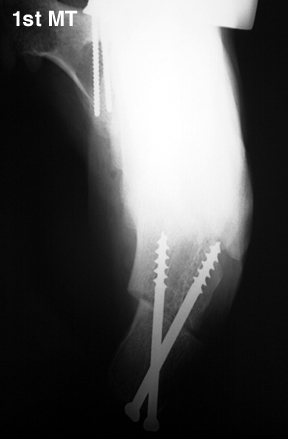Table of Contents
Pes Cavus
Introduction
Pes cavus describes a foot with a high arch that does not reduce with weight bearing (14). This deformity may originate in the hindfoot, the forefoot, or both. There are many variations in associated soft tissue and bony abnormalities that occur. Usually, there is a hindfoot varus component, thus the term pes cavovarus.
Pes cavus in a patient with Charcot-Marie-Tooth disease (image courtesy of Wikipedia)
These alignment abnormalities are usually secondary to muscular imbalances, caused by congenital or idiopathic lesions of the nervous system. One of the more common causes is Charcot-Marie-Tooth disease. Other less common causes are myelodysplasia, poliomyelitis, and Freidrich's ataxia.
The muscle imbalances of pes cavus foot are variable, depending on the underlying etiology. Typically, with Charcot-Marie-Tooth disease, the anterior compartment muscles (tibialis anterior) are weak. With normal strength in its antagonist, the peroneus longus, an equinus deformity develops, and the first ray is plantarflexed. There is weakness in the peroneus brevis muscle and normal strength in the posterior tibialis muscle, resulting in a varus deformity, hence the term “equinovarus foot”. Hindfoot deformities gives rise to supination of the foot which often results in the patient bearing weight on the lateral side.
Radiographic measurements
The typical findings with Charcot-Marie-Tooth disease are: (most useful measurements in bold)
FOREFOOT/MIDFOOT ADDUCTION
- AP: Medial peritalar subluxation
HIGH LONGITUDINAL ARCH:
- Lateral: Increased calcaneal pitch (variable)
- Lateral: Abnormal talometatarsal angle
HINDFOOT VARUS
- AP: Decreased talo-calcaneal angle
OTHER FINDINGS:
- Lateral: Externally rotated tibia/talus
- Lateral : “See-thru sign” of sinus tarsi
Most useful measurements
Medial peritalar subluxation
The finding of medial peritalar subluxation with pes cavus is essentially the opposite of what is seen in pes planus. Instead of a weakened posterior tibialis tendon, producing lateral subluxation, there is usually a relatively strong posterior tibialis which is unopposed by a weakened peroneus brevis tendon, producing medial subluxation of the navicular on the talus.
Increased calcaneal pitch angle
When the predominate component of pes cavus originates in the hindfoot, it often manifests as a high calcaneal pitch on lateral radiographs. Measurement of calcaneal pitch has been discussed above. 18 to 20° is generally considered normal (12), although measurements ranging from 17 to 32° have been reported to be normal (5).
a. Normal calcaneal pitch.
b. Abnormally high calcaneal pitch consistent with pes cavus.
Lateral talar - 1st metatarsal angle
Probably the most familiar line to radiologists, and a more direct measurement of pes planus, or collapse of the longitudinal arch, is the talar-1st metatarsal angle (Meary's angle)(3). This is an angle formed between the long axis of the talus and first metatarsal on a weight-bearing lateral view (Fig a). This line is used as a measurement of collapse of the longitudinal arch. Collapse may occur at the talonavicular joint, naviculo-cuneiform, or cuneiform-metatarsal joints.
In the normal weight-bearing foot, the midline axis of the talus is in line with the midline axis of the first metatarsal. An angle that is greater than 4° convex downward is considered pes planus (Fig b) with an angle of 15° - 30° considered moderate , and greater than 30° severe (8, 9).
The lateral talar - 1st metatarsal (Meary's) angle may be increased in pes cavus. A foot with an angle greater than 4 degrees convex upward is considered a pes cavus(10, 11).
a. Normal talar - 1st metatarsal (Meary's angle).
b. Abnormal Meary's angle, convex upward, indicating pes cavus. This angle is useful for pes cavus whether it originates in the hindfoot, midfoot, or forefoot.
Other measurements
Decreased talocalcaneal angle
This angle may be difficult to measure because the hindfoot is often obscured on AP views of the foot. A line is drawn through the mid-axis of the talus and another along the lateral border of the calcaneus (Fig a). The range of normal for adults is 15-30° (14). An angle less than 15° indicates hindfoot varus (Fig b).
Sinus tarsi "see-through" sign
This sign is not so much a reflection of intrinsic abnormal alignment as a function of positioning of a cavovarus foot. Conventional weight-bearing radiographs place the x-ray cassette against the medial forefoot and hindfoot. With cavovarus foot there is forefoot adduction and hindfoot varus, which produces a relative external rotation of the tibiotalar and subtalar joint, causing the longitudinal axis of the sinus tarsi to be in the plane of the x-ray beam.
The sinus tarsi “see-through” sign. This sign is not specific for pes cavovarus, but indicates external rotation of the hindfoot. This is often seen with the varus and forefoot adduction deformities present in pes cavovarus.
Double talar dome sign
Just as with the sinus “see-through” sign, this sign is a function of relative external rotation of the hindfoot with positioning for the radiograph. Both medial and lateral aspects of the talar dome are visualized. This often makes it difficult to measure the longitudinal axis of the talus accurately. Notice also the posterior position of the fibula due to external rotation.
Both medial and lateral talar dome are visible, indicating rotation of the hindfoot.
Reconstructive surgery for pes cavus
Surgically correcting a cavovarus foot can be performed in a number of ways. The approach at Harborview is to address the underlying cause (muscle imbalance) as well as correct the deformity. Most of the corrections involve tendon transfers and capsular and fascial releases, which are not visualized on x-rays. However, there are a few operative corrections that can be visualized. These include:
- Correction of plantar flexion of the first ray by performing a dorsiflexing 1st tarsometatarsal arthrodesis.
- Reduction of hindfoot varus by performing a lateralizing calcaneal osteotomy.
 |  |
| a. Arthrodesis of the first tarsometatarsal joint to reduce plantar flexion of the first ray. | b. Lateralizing calcaneal osteotomy to correct hindfoot varus. |
c. Lateral view showing both 1st TMT fusion and lateralizing calcaneal osteotomy.













